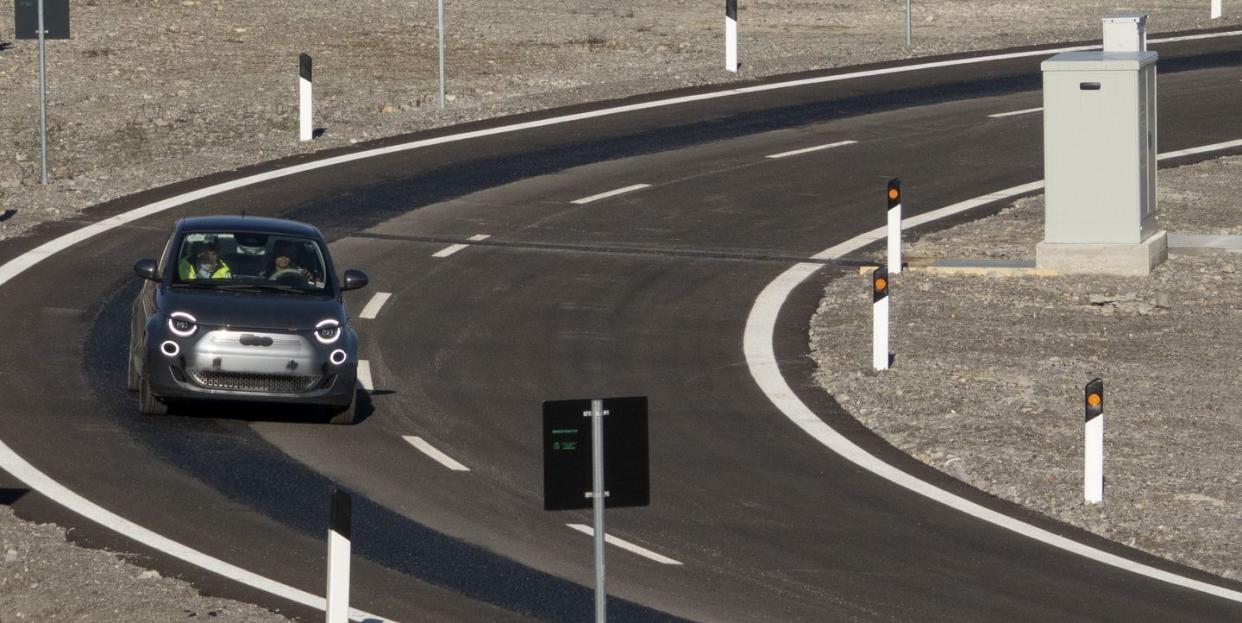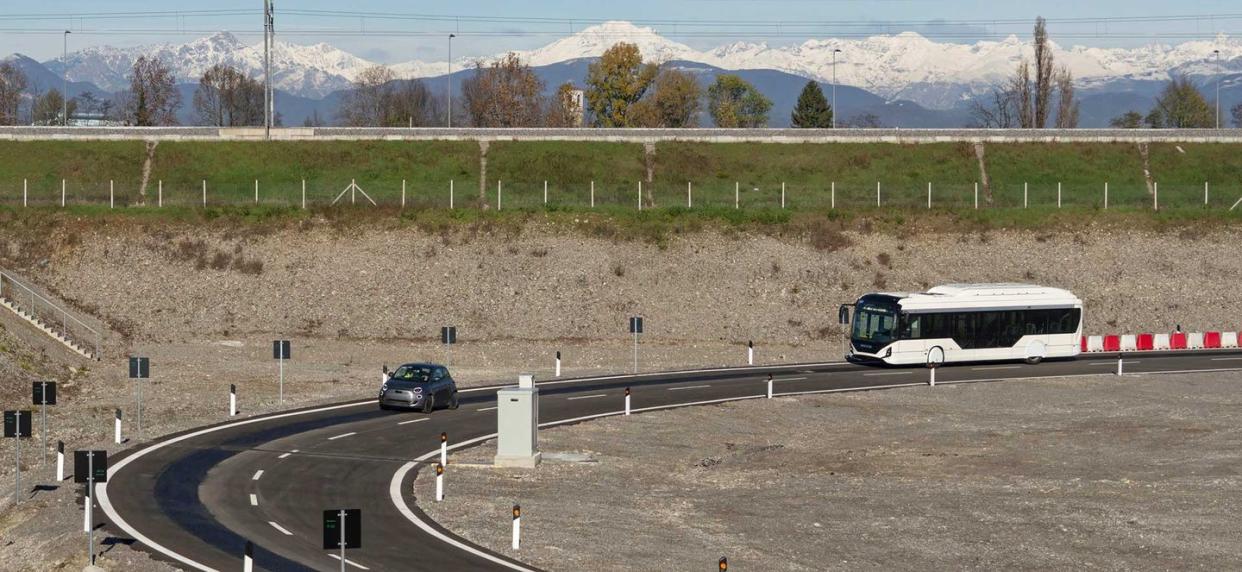This Electrified Road Charges Your EV as You Drive

A new pilot project in Italy proves that on-the-move, in-road electric vehicle charging is possible.
Coils under the asphalt transfer energy to on-vehicle receivers.
In Detroit, a one-mile stretch of road will use a similar magnetic induction system to charge vehicles.
On a roadtrip sometime in the near future, you can forget any concerns about your electric vehicle’s range, or about finding a high-speed charging station along the way. That is, if electrified roads become the norm, as a new pilot project in Milan, Italy demonstrates is entirely possible.
This inductive charging technology powers an electric vehicle from underneath the roadway while the vehicle is still on the move. But expanding that technology from a one-mile test track into a real-world highway won’t be a simple—or inexpensive—step. No one has a realistic roadmap in place to execute this dream project on a large scale, just yet.
That doesn’t mean companies aren’t trying to make electrified roads a reality. On June 10, Stellantis—the Amsterdam-based parent company of Fiat, Chrysler, Dodge, Jeep, and Ram, among other auto brands—announced a successful run of its “Arena of the Future” project just off the A35 Motorway near Milan, Italy. The company crafted a 0.65-mile loop track embedded with the inductive technology, and then successfully powered its Fiat 500, along with buses and other vehicles, while driving on the track.
In this design, a groove in the roadway is cut out to install inductive charging coils, fed by electrical power. The coils are covered in asphalt, just like a typical road, so that cars can roll on a regular driving surface. A receiver on the underside of the vehicle grabs that electromagnetic power and sends it straight to the engine, reducing (or even eliminating) reliance on an EV’s stored battery charge.
Direct current powers the Arena of the Future, which reduces power losses in energy distribution, and makes it possible to use thinner cables than an alternating current.
The Stellantis Dynamic Wireless Power Transfer technology proved that it can allow a battery-powered electric vehicle to travel at typical highway speeds without consuming the energy stored in its battery.
“Our long-term strategic plan, Dare Forward 2030, is based on the premise of bringing cutting-edge freedom of mobility to all and this project is the very essence of where we’re headed as a company,” Anne-Lise Richard, head of Stellantis global e-mobility business unit, says in a news release. “We have proven that inductive recharging technology can power our electrified future.”
Italy isn’t alone in pilot-testing this type of wireless-charging system. Work is already underway to sort out a one-mile test road in Detroit, Michigan under the direction of Governor Gretchen Whitmer. Michigan’s hope is to create an electrified roadway system that charges electric buses, shuttles, and vehicles while driving. Germany, Sweden, and Israel have similar programs underway.
Academic research also underpins the desire to innovate wireless charging for EVs. A team at Cornell University goes beyond using magnetic induction to highlight the possibility of high-frequency inverter technology. Their active-variable reactance rectifier puts magnetic plates beneath the vehicle that are connected to a power line. They carry a high-frequency current through a circuit on the vehicle, charging the battery.
But even as such wireless technologies are proving possible across North America and Europe, the reality of an overhauled roadway system may not be so simple.
While the Indiana Department of Transportation announced plans to create its own test bed for this kind of technology on a quarter-mile stretch of highway, the project is years away from being embedded into existing roads. Chris Mi, an electric vehicle charging expert at San Diego State University in California tells Grist the concept isn’t feasible or economically viable at large scales.
There are multiple problems. Chiefly, you have the unknown costs of converting existing roadway by installing the induction system within asphalt. Plus, every car needs to be adapted with a receiver to accept the technology. Still, the transportation department has partnered with Purdue University, German technology provider Magment, and the National Science Foundation’s Advancing Sustainability through Power Infrastructure for Road Electrification Initiative (ASPIRE) as it moves ahead with pavement tests and research.

With any new technology, the unknown variables are abundant. In this case, there’s the cost of installation to consider, and the durability of a system just inches below weather-beaten asphalt. Then there’s the concern about funding this project amidst other potential sustainable infrastructure projects.
Proponents of the technology say that not only can entire roadway systems be outfitted with on-the-go charging, but the technology could work for parking lots, intersections, and virtually any place where readily-available power can supply under-the-road charging. Some of the funding could come from tolls for vehicles drawing power from the system.
The future of EV wireless charging is still a question mark, but engineers, infrastructure specialists, and policymakers continue exploring the electrifying possibilities.
You Might Also Like
